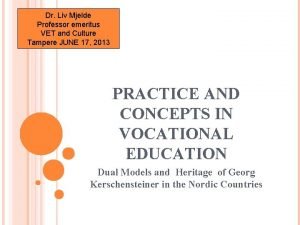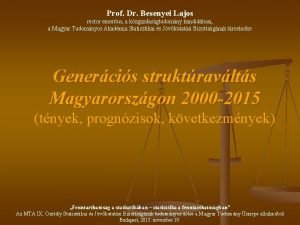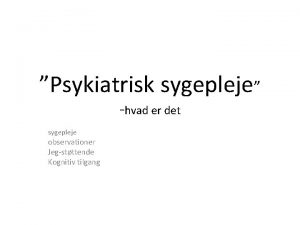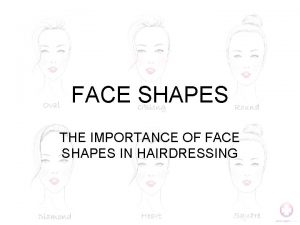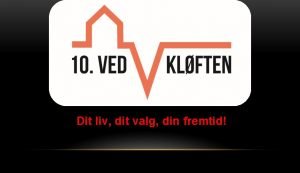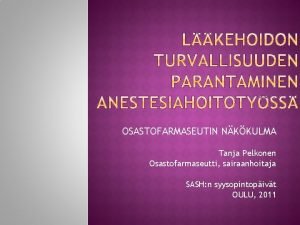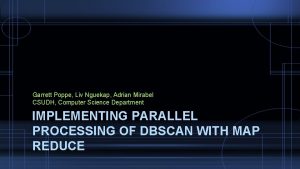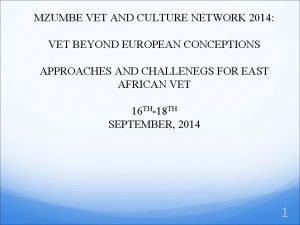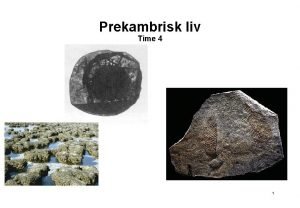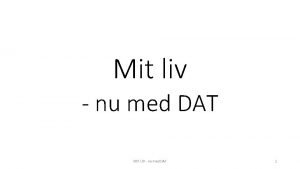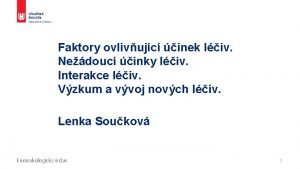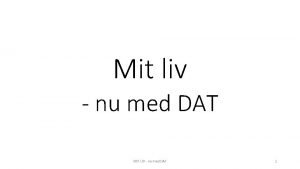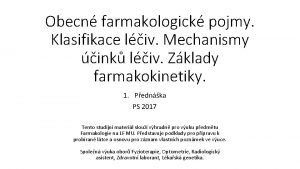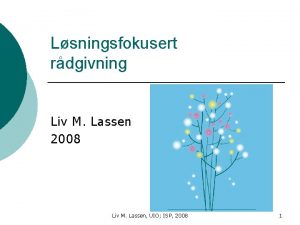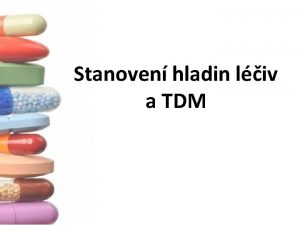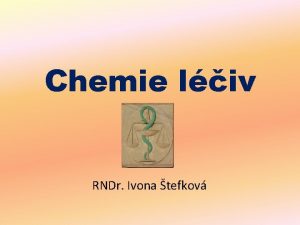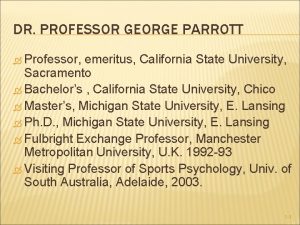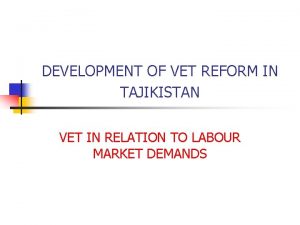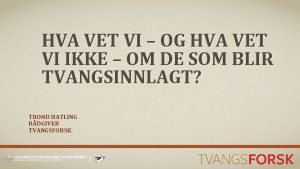Dr Liv Mjelde Professor emeritus VET and Culture

























- Slides: 25

Dr. Liv Mjelde Professor emeritus VET and Culture Tampere JUNE 17, 2013 PRACTICE AND CONCEPTS IN VOCATIONAL EDUCATION Dual Models and Heritage of Georg Kerschensteiner in the Nordic Countries

SOGN VOCATIONAL SCHOOL THE ETON OF TRADE AND INDUSTRY

VOCATIONAL EDUCATION IN NORWAY 2013 The upper secondary education oriented towards the trades. (age: 16 -19) Today there is a combination of two years in school and two years apprenticeship. There are 180 trades regulated by the Law of Apprenticeship. 50 % of the youth cohort enter vocational trades after 10 years of compulsory schooling.

INSPIRATION FROM GERMANY 1900 -2000 Inspirator in 1900 Arbeitsschule-Activity School Dr. Georg Kerschensteiner from 1960’s The dual model Workshops in schools in vocational education combined with apprenticeship in working life.

THE SPECIAL CHARACTERISTICS OF VOCATIONAL EDUCATION IN SCHOOLS

WORKSHOP SCHOOL – MACHINISTS, CA. 1910

VOCATIONAL THEORY: PLUMBER APPRENTICES, TRONDHEIM, 1918

HAIRDRESSING APPRENTICES, ELVEBAKKEN SCHOOL, 1935

ROOTS OF VOCATIONAL EDUCATION IN SCHOOLS Feudal Guild Master- apprentice Traditions Work Techniques Training in the use of tools in actual, concrete work situations Vocational Theory Schola Cathedral Traditions General Academic components Norwegian, civics, mathematics, physics, chemistry, etc. . , unrelated to vocations Knowledge about materials, use of tools and equipment, technical drawing Linked to practical working life Remote from working life

CLASSICAL MODELS OF VOCATIONAL EDUCATION Britain: the liberal market model. VET takes place in a variety of places, in schools, in firms and factories France: the state regulated model VET takes place in production schools Germany: the dual corporate model. VET takes place in a pre-determined alternation between companies and schools

ANJA HEIKKINEN: “MODELS, PARADIGM OR CULTURES OF VOCATIONAL EDUCATION” There has been an emergence and transformation of national systems and the development of continuing vocational education and training in Northern Europe and this may be the result of competition between the different “cultural conceptions” borne by individuals and collective bodies in different countries.

GEORG KERSCHENSTEINER 1854 -1932 The concept of «Arbeitsschule» , «activity school» - «workshop school» The Continuation school in Munich. Civic Education for the working class «Arbeit durch Freude» Joy in Work

HENRIK SOLHEIM CRAFTS AND INDUSTRY ASSOCIATION asked the question, using the trade school of Munich as a model: Just because of this, Germany seems to have taken the lead in the area of industry and crafts, to the point where America, England, Sweden and Australia are seriously asking themselves “What is the reason for this? ”. …. .

HENRIK SOLHEIM: THE ANSWER “Some time ago, the American periodical Harpers Weekly also carried an article on this subject that determined that the workshop school system is the reason for the Germans taking the lead in all industrial and crafts trades. Germany’s trade schools, it says reveals the secret of this country’s amazing commercial and industrial luck and its peremptory position as a world power”

NORDIC COOPERATION AND VET IN CRAFTS AND INDUSTRY The first Nordic Meeting on vocational education: in Stockholm, 10 -12 July 1924. 450 participants Denmark, Finland, Norway, Sweden Mainly representatives from Crafts and Industry(? ) 12 main speeches from the four countries.

MAIN TOPICS The building of Workshop schools The relation between workshop-school and apprenticeship in work life in crafts and industry Apprenticeship Laws The involvement of the state/municipalities in Vocational Education and Training. The civic education of the working classes

DAN HUUN THE CHAIRMAN OF BERGEN CRAFTS AND INDUSTRY ASSOCIATION SAID IN 1919 “No question is more important for a country than the youth- the folkeducation- forming good and useful citizens. Work skills and the pleasure of work are the factors necessary to induce in the youth. That must be done in practical schools. ”

DAN HUUN HE SAYS FURTHER (1919 P. 8. ) “Munich, the capital of Bayern is the place in foreign countries that has the best organized and the most detailed practice of continuation schools. The creator of this continuation school in Munich is Dr. Kerschensteiner. ”

GEORG KERSCHENSTEINER’S IDEAS PUBLISHED IN THE NORDIC COUNTRIES Kerschensteiner, G. (1910). Grundfrågor rörande skolans organisation. Stockholm: Förbundet. Kerschensteiner, G. (1980). Arbejdsskolen. København: Nyt Nordisk forlag. Sunnanå, O. (1960). Georg Kerschensteiner og arbeidsskulen. Oslo: Det Norske Samlaget. In Finland today: «Education for Citizenship & «Three Lectures on Vocational Training.

MAIN CONCEPTS AND PRACTICE GEORG KERSCHENSTEINER AND JOHN DEWEY IN THE NORDIC COUNTRIES Georg Kerschensteiner: Concept: «Arbeitsschule « «Workshop school» Practice: The trade school of Munich John Dewey Concept: Learning by doing Practice: The Laboratory schools in. Chicago

HERITAGE TODAY? : Reform pedagogy, Activity pedagogy, progressive schools, reform schools. Experiential learning The Work Method is the curriculum. Learning by Doing

CHALLENGES IN THE SOCIAL DIVISION OF KNOWLEDGE There are contradictions! intellectual vs. manual labour, the work of hand vs. work of mind and heart, vocational vs. general education workshop/vocational learning traditions vs. general/classroom learning traditions These are discussed on a higher level than ever before, whether you are in Canada, Africa, Latin America or Europe.

IS KERSCHENSTEINER AND DEWEY IN VET IMPORTANT TODAY? Historical perspectives on vocational education are essential for vocational education’s self awareness as a scientific and scholarly discipline. (Schreiver & Harney 1999)

PRINTING WORKSHOP, SOGN VOC SCHOOL, 1982, (TEACHER/MENTOR, 3 RD FROM LEFT)

TRONDHEIM TECHNICAL SCHOOL, APPRENTICE ELECTRICIANS, 1922.
 Liv mjelde
Liv mjelde As jamal develops his presentation
As jamal develops his presentation Regents professor emeritus
Regents professor emeritus Vet to vet
Vet to vet Asu emeritus college
Asu emeritus college Rector emeritus
Rector emeritus Promotion from associate professor to professor
Promotion from associate professor to professor Non material culture
Non material culture Batch culture vs continuous culture
Batch culture vs continuous culture Difference between american culture and indian culture
Difference between american culture and indian culture Stroke culture method
Stroke culture method Folk culture and popular culture venn diagram
Folk culture and popular culture venn diagram Popular culture examples
Popular culture examples Anaerobic media
Anaerobic media Homework due today
Homework due today Anaerobic culture method
Anaerobic culture method Explain stab culture and stroke culture
Explain stab culture and stroke culture Surface culture deep culture and esol
Surface culture deep culture and esol Moderlige og faderlige principper
Moderlige og faderlige principper Liv tan
Liv tan Liv tyler face shape
Liv tyler face shape Skolerejse til stockholm
Skolerejse til stockholm Liv-kaappi
Liv-kaappi Liv garrett
Liv garrett Liv otto hassert
Liv otto hassert Jeg støttende sygepleje liv strand
Jeg støttende sygepleje liv strand
